Mirella Sichirollo Patzer's Blog, page 13
November 20, 2015
Beauty Secrets of the Victorian Era
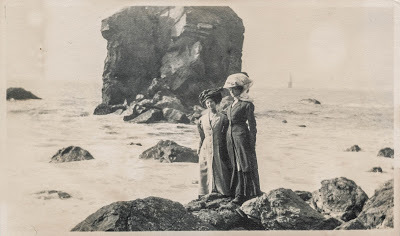
Beautiful, amazing magnificent – it is all about the Victorian era. Stiff manners, stiffer corsets, extreme moral conservatism and minimum makeup – all these was compensated by huge and gorgeous haircuts. Nineteenth-century women revealed their secrets of being beautiful and keeping a man. Read our article and dive into this atmosphere of dancing, ball gowns and young and fresh beauty.
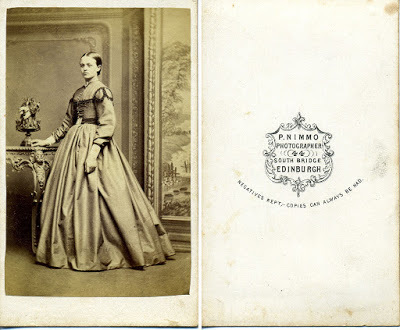
The Body Pale skin and complexion at the Victorian era were marks of celebrity and high social status. Women used different poisons like masks and pills to lose weight and get “sick look”, which was so coveted at that time.
MakeupIt was unacceptable for woman of high class to buy cosmetics. Their motto was “natural skin and minimum makeup”. Eye shadows were made with antimony sulfide, lipsticks with mercuric sulfide; blushes were simply beet juice. But that all was used very gentle, because the main concept was to look like you don’t wear makeup at all.
Dark circles under your eyes and translucent skin with blue veins, which are seen through it – here how “perfect skin” of the Victorian era looks.
If you have oily skin type, a little amount of powder can be used, but not much. Just enough to add some glow to your face.

Skin care In order to get pale skin, women used all kind of masks and creams, made of natural products that can be found at the kitchen. Thanks God, this tradition replaced “poison cult”. Almond oil and different waxes were widely used. Toners were made of water and all kinds of flowers, such as roses, chamomiles, or violets.

HairAt the Victorian age women were proud of their hair and did everything to strike everybody around. They cut their hair very rare, and if they did, false hair was used instead for bigger volume. Among most widely spread hairdos were chignons, buns and long curls, falling at the back or sides. Oils and waxes were also used to make hair look sleek and smooth.

Men`s fashion was much more simple. They tended to cut their hair short and grew their beards long, like a sign of real man.
So, now you know all beauty secrets of the Victorian age. Ask yourself: would you like to live at that time?
See more here http://bonbonsalon.com/










Published on November 20, 2015 11:11
November 19, 2015
Nurses at War by Jean Bowden
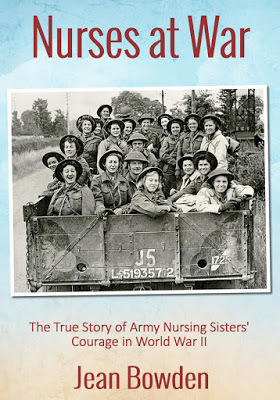 Nurses at War
remembers the brave nursing sisters of the Queen Alexandra’s Imperial Military Nursing Service (QAIMNS), known with admiration by their grateful patients as the ‘Q.A.s’.
Nurses at War
remembers the brave nursing sisters of the Queen Alexandra’s Imperial Military Nursing Service (QAIMNS), known with admiration by their grateful patients as the ‘Q.A.s’.These dedicated women faced danger and sometimes death to care for wounded servicemen during the Second World War. They worked tirelessly in the field – their lives constantly at risk, but throughout they showed courage, spirit and even humour. Among tales of fear and heartbreak, there are also many moments of compassion and hope.
The inspiring nursing sisters worked in the most dangerous places of action during World War Two ‒ including Dunkirk, Malta, Hong Kong and El Alamein. They encountered death and disease on an unprecedented scale, suffered harsh imprisonment by the Japanese, and were bombed while on board hospital ships and trains. But wherever they found themselves, the sisters continued to carry out their duties with professionalism and a plucky determination.
First published to great success and acclaim in 1959 as Grey Touched with Scarlet, this book has been written based on the first-hand accounts of the army nursing sisters.
Links:
www.amazon.co.uk/Nurses-War-Nursing-Sisters-Courage-ebook/dp/B017F0JSZA/
www.amazon.com/Nurses-War-Nursing-Sisters-Courage-ebook/dp/B017F0JSZA/
www.amazon.com.au/Nurses-War-Nursing-Sisters-Courage-ebook/dp/B017F0JSZA/
http://www.amazon.ca/Nurses-War-Nursing-Sisters-Courage-ebook/dp/B017F0JSZA/ref=sr_1_4?ie=UTF8&qid=1447963262&sr=8-4&keywords=nurses+at+war
ExcerptNurses at War The True Story of Army Nursing Sisters' Courage in World War II by Jean Bowden
The following excerpt describes what happened to a group of shipwrecked people, mainly women and children, who were fleeing Pom Pong Island in the Far East.
Then in the middle of the night a boat came in, the Tanjong Penang. Between two hundred and fifty and three hundred women and children were loaded aboard her, as well as most of the sick. In view of this latter contingent, the captain asked if he could have some of the nurses. Turner was one of those who went aboard, her borrowed grey dress in a filthy state and her neat dark-brown hair a mass of tangle above her angular face.
The woman doctor aboard had her work cut out. The Q.A.s were at her side for orders as soon as the little ship set sail, and worked without cease all day. Then at night, as a reward, they were allowed to stay up on deck to sleep.
It was nine o’clock at night. Sleeping figures sprawled about the decks. And then suddenly they were half-sitting up, rubbing their eyes and flinching away from the hard green glare of the light which blazed down on them.
Next moment, in rapid succession, two explosions. The little ship shuddered and keeled over.
What had hit them they never knew. Perhaps a Japanese destroyer had shelled them. All around Turner were dead bodies, limbless and shattered and horrible in the dying green light. A moment ago these had been her friends, sitting up and exclaiming, ‘What on earth’s that?’ Now ‒ jumbled and bloody flesh.
‘The hold!’ cried Turner, scrambling to her feet. The women and children were in the hold. Her long-limbed body sped along the deck to the companionway.
A V.A.D. in a ghastly, bloodstained dress was struggling up it. ‘It’s no use,’ she half-sobbed. ‘They’re all dead.’
‘But ‒ Are you sure?’
‘My own mother’s there. I’m sure.’
The deck was at an angle of sixty degrees. Together they slid down to the rail and ‒ literally ‒ stepped into the water. Why they were not sucked under when the ship plunged down, only God knows. They came up among the floating debris of the wreck and after treading water for a few minutes made for one of the rafts washing about to their left. After resting there for a space they caught another raft as it drifted past and tied them together.
During the night these two young women swam out and brought to safety no less than sixteen people, including six children. Two of the children were under a year old. Two people sat on the raft, back to back, each holding a baby, while all the others held on to the lifelines.
Turner did all she could to instil the importance of never letting go, but after dawn it was found that two of the survivors had gone. That left two women on the raft, each holding a baby; four children holding the lifelines, six, seven, eight and ten years old; and eight women.
The first day Margot Turner spent alternately swimming out bringing back people who drifted off, and trying to make contact with other rafts which drifted by on the currents. She never saw these rafts again.
The captain of the Tanjong Penang hailed them from a distance. He was in a lifeboat with one of the ship’s officers.
‘Can you keep afloat?’
‘For a little while, I think. Can you pick us up?’
‘This boat’s stove in ‒ it’s leaking like a sieve. If I take anyone aboard it’ll go straight to the bottom.’
‘What are we to do?’ Sister Turner shouted despairingly.
‘Try to keep afloat. I’m going to try and make it to land.’
‘Are we near land?’
‘I think so. Just try to keep on the raft ‒ keep afloat. I’ll get help, if this boat doesn’t sink under us.’
Turner wiped the salt water off her lips and called, ‘What happens if you don’t make it?’
A pause.
‘Perhaps a Dutch plane will fly over. Otherwise … if we don’t make it to land, well, we’ve got to make it, that’s all.’
That was the last time Turner ever saw the ship’s captain.
Sister Le Blanc Smith had said during the night that she thought she was wounded, but not badly enough, so she insisted, to need to be put up on the raft. She could hold on, she said. At first light her deathlike colour so alarmed Turner that she hoisted her up out of the water ‒ to find that Sister Le Blanc Smith had an absolutely desperate wound in the buttock. Without complaint this gallant woman had hung on to a lifeline all night while others rested on the raft.
Now Turner commanded Le Blanc Smith to take a turn on the raft. But it was too late. Le Blanc Smith died that afternoon.
Two other women gave up their grasp on the lifeline and were carried away despite Turner’s efforts to hold them back. She felt she simply had not the strength to go after them. The heat of the sun was unbearable on salt-drenched flesh, and it was impossible to provide the least shelter for the babies. They were parched with thirst. Turner found a powder compact in her uniform pocket, in which she tried to catch some of the rain from the drenching tropical storms which from time to time burst over their heads. But the quantity she saved was so minute ‒ and the children were so thirsty.
And so the babies died. Turner examined them with desperate care before committing their small bodies to the sea. If, by any unimaginable luck, she ever reached land, she might meet an ill and broken-hearted woman who would say to her, ‘And my little boy? Did you see him anywhere?’ When Turner answered, ‘He was on the raft with us but he died on the second day,’ she had to say it with absolute conviction.
But they were dead ‒ from shock and exposure and exhaustion. One was nine months old, the other almost a year.
There were now ten people left ‒ four children and six adults. Two of the women were V.A.D.s who, with Sister Turner, did all they could to hold the others to the raft. But when the night was past and the third dawn flared up out of the sea, three more women were missing.
The children were pushed up on the raft, but they were in hopeless case. As the heat of the day increased, so their hold on life and sanity waned. They threshed about, falling into the water, failing to catch the lifelines. The women grabbed at them, trying to still the failing limbs and make them keep hold of the one hope of life, the raft. But their efforts were foredoomed. One by one they lost the children.
That afternoon there were only two of them left ‒ Turner and another woman. Turner’s lifebelt had chafed her chin until it was raw and weeping; she straggled out of it and tied it, together with her companion’s, on the raft. They sat back to back and watched the little green islands creep up out of the sea as the current swept them along. Hundreds of little islands, meaning dry land and comparative safety ‒ but how were they to reach them?
They caught two pieces of driftwood and with these began to paddle weakly towards the little feathery outline on the horizon which was a palm-fringed reef. The currents were overbearingly strong. They made no headway. It was hot, so hot.
Sister Turner’s companion let her paddle slip from her grasp. She gave a gasp of alarm and, to get it back, plunged into the sea. Turner was too late in her clutch at her dress. In a matter of moments she was gone, irretrievably, having in her lurching jump dragged the lifebelts with her.
Too weak to swim after her, Turner called and strained her eyes to catch a glimpse of the slip of white which was her last link with humankind. But there was nothing. Nothing but the blinding sparkle of the sea, the glaring sunlight overhead, and a long way off, the little dot of black towards which they had been paddling. By and by it vanished too.
She was guiding the raft up a tropical river. A cheerful English voice called, ‘Hello there, Sister! You’re in a state, aren’t you?’ The raft was pulled in to the shore, she was offered a cup ‒ could it be? ‒ a cup of tea. With trembling hands she took it, and the tea spilled and made her wrist wet ‒ She was trailing her hand in the sea. That was why her wrist was wet. She was still alone, and the sea was still vast, and the sun was still shining although it was nearing the horizon. She had been dreaming. What a pity she had woken up before she drank the tea.










Published on November 19, 2015 12:03
November 9, 2015
The Goddess of Yoga!
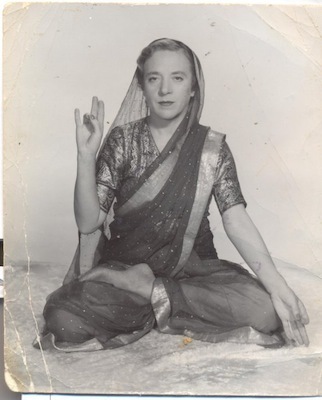 How did a young Russian woman named Eugenie V Peterson, who fled Moscow during the Bolshevik Revolution become one of the world's greatest yoga practitioners? The Goddess and First Lady of Yoga with a new, adopted name of Indra Devi? Well, in the world Eugenie was born into, little was known about yoga. Her passion was ignited when she read a book by the great poet-philosopher Rabindranath Tagore. At about the same time, she stumbled upon a yoga instruction book by Yogi Ramacharaka. So strong was her fascination, that in 1927 she travelled to India. Her beauty gave her easy entry as an actress in the burgeoning Indian film industry. She met and fell in love with a handsome attache to the Czechoslovakl consultate in Bombay by the name of Jan Strakaty. Through him she met the Maharaja and Maharini of Mysore. At their palace, she met the famous yogi, Sri Tirumalai Krishnamacharya.
How did a young Russian woman named Eugenie V Peterson, who fled Moscow during the Bolshevik Revolution become one of the world's greatest yoga practitioners? The Goddess and First Lady of Yoga with a new, adopted name of Indra Devi? Well, in the world Eugenie was born into, little was known about yoga. Her passion was ignited when she read a book by the great poet-philosopher Rabindranath Tagore. At about the same time, she stumbled upon a yoga instruction book by Yogi Ramacharaka. So strong was her fascination, that in 1927 she travelled to India. Her beauty gave her easy entry as an actress in the burgeoning Indian film industry. She met and fell in love with a handsome attache to the Czechoslovakl consultate in Bombay by the name of Jan Strakaty. Through him she met the Maharaja and Maharini of Mysore. At their palace, she met the famous yogi, Sri Tirumalai Krishnamacharya. 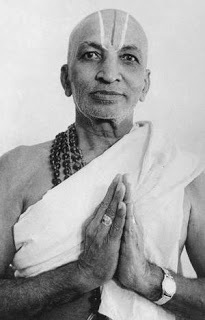 The desire to study yoga continued to blossom in her heart and mind, but remained only a dream. In those years, only men could study yoga. Meanwhile, Indra and her husband immersed themselves in India's social life. It was a whirlwind of dances and balls, races and festivities and she came into contact with India's elite - even Mahatma Gandi. Their hectic lives took its toll on her. She began suffering from unexplained chest plains which no amount of treatment or cures helped resolve. Then someone suggested she practice yoga. So of course she approached Krishnamacharya, and of course he refused, for she was not only a westerner, but even worse, a woman! So great was her desire to practice yoga, that the Maharaja himself finally intervened and urged Krishnamacharya to aceept her into his school. Krishnamacharya was very hard on her. He set her up for long hours of practice in cold rooms, severe diet restrictions, and the same grueling regime he demanded of his male students. Not only did she meet every one of his demands, but she did so with eagerness. Krishnamacharya became so impressed with his zealous student that he began giving her private lessons. Soon, her health issues disappeared. She had never been happier. This great yogi had ignited her dedication, which would ultimately lead her to gain notariety in every corner of the world.
The desire to study yoga continued to blossom in her heart and mind, but remained only a dream. In those years, only men could study yoga. Meanwhile, Indra and her husband immersed themselves in India's social life. It was a whirlwind of dances and balls, races and festivities and she came into contact with India's elite - even Mahatma Gandi. Their hectic lives took its toll on her. She began suffering from unexplained chest plains which no amount of treatment or cures helped resolve. Then someone suggested she practice yoga. So of course she approached Krishnamacharya, and of course he refused, for she was not only a westerner, but even worse, a woman! So great was her desire to practice yoga, that the Maharaja himself finally intervened and urged Krishnamacharya to aceept her into his school. Krishnamacharya was very hard on her. He set her up for long hours of practice in cold rooms, severe diet restrictions, and the same grueling regime he demanded of his male students. Not only did she meet every one of his demands, but she did so with eagerness. Krishnamacharya became so impressed with his zealous student that he began giving her private lessons. Soon, her health issues disappeared. She had never been happier. This great yogi had ignited her dedication, which would ultimately lead her to gain notariety in every corner of the world. So avid a learner was she, that she exceeded all Krishnamacharya's expectations, achieving all the goals set for her. He was so impressed, that when he learned her husband had been transferred to work in China, he encouraged her to work as a yoga teacher there. Thus, by 1938, she became the first foreign woman to be a yogi. In China, she opened her own yoga school, giving lectures, and teaching it in orphanages. Her popularity grew and soon she became known as "Mataji" or "Mother". When her husband died in the mid 1940's she set off for Hollywood and opened a studio there. Greta Garbo, Eva Gabor, and Gloria Swason were a few of her students. Her fame and reputation grew!
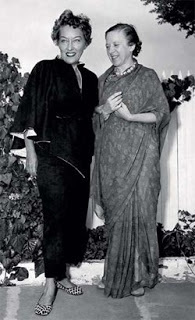
Indra with Gloria Swanson
After several more years passed, Indra met and married a renowned German physician named Dr. Sigfrid Knauer. She became an American citizen in the mid-1950s. Indra continued to expand her business and opened a school in Mexico. Sadly, in 1960, her husband died in a car accident in California and she found herself widowed once more.
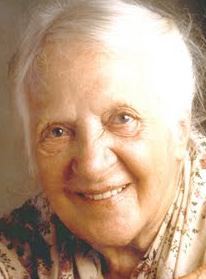
With marriage well behind her, she turned her focus more and more on yoga. She travelled often, finally settling in Argentina in 1972 where she earned further acclaim when elected president of the International Yoga Federation and the Latin American Union of Yoga. 3000 guests came to her 100th birthday party. With her great age came failing health. She died in Argentina in 2002 where her body was cremated and her ashes scattered over the Rio de la Plata.
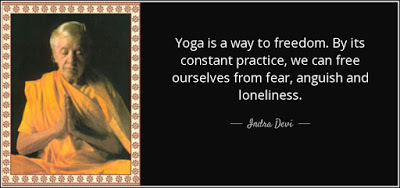
So with all the health benefits of yoga, it's something every woman should consider as part of an exercise routine. I began with Namaste Yoga for quality, expertise, and ultimate instrudtion.
 Namaste Yoga - Season 1 Part 1
Namaste Yoga - Season 1 Part 1Product Description:
Namaste Yoga is designed for people who want to become fitter, live healthier, and be happier. With these six, 22-minute episodes, you can experience what yoga at home should feel like: stunning visuals, soothing music, and entirely original movement sequences that will calm the mind, strengthen the body, and inspire the soul. We know that when it comes to choosing a yoga DVD, there are a lot of options for you. Here are a few qualities that we feel make us unique.
Universal. Namaste was designed for you. Whether you are brand new to yoga or have been practicing for years, our sequences can always be used to enhance your wellbeing - no matter what stage of life or level of fitness.
Original. Kate Potter's style is unique to Namaste Yoga. Our sequences combine postures in ways not found in any other style of yoga. The sequences emphasize flowing, graceful movements and gentle learning through repetition.
Complete. Not everyone has 90 minutes every day to devote to a yoga practice. At only 22 minutes per episode, Namaste is a complete yoga practice for tight schedules. And for those days when you just can't get off the mat, there are hundreds of ways to combine the sequences for a customized practice that is your ideal length.
Inspiring. With stunning visuals, soothing music, and gentle instruction, Namaste Yoga strives to go beyond ordinary workout DVDs to inspire you to reach all of your health and wellness goals - both on and off the mat.
Proven. Thousands of people have lost weight and gained flexibility, strength, and confidence by practicing Namaste Yoga.
Review:
There are countless benefits to yoga, and researchers hail its numerous, powerful benefits. I am a 56 year old novelist, so I spend long hours each day at my desk. I embarked on a yoga program to stretch and keep my muscles limber. Namaste Yoga is a world leader and innovator in yoga with a strong reputation in the field, so I felt that their videos were the best way to begin. And I am pleased to say that I was right! Visually stunning, the Namaste Yoga DVD narrated by Kate Potter is wonderful for beginners like me. The video has 6 segments/poses: exalted warrior, sun moon, firebird, gate opening, dancing sun, and half moon. Each segment is 22 minutes long. The beauty of this yoga instructional dvd is that my body was challenged, and the more I practice, the better I get. There are no poses that caused me to lose my balance or over-worked my muscles. There is both a warm up and cool down phase. Along with my time in the gym on the treadmill and some weight training, this yoga dvd has been a wonderful addition to my work-outs. Kate Potter's soothing voice, gentle style, set against beautiful backgrounds and relaxing music, makes practicing yoga a wonderful gift to myself. I look forward to the end of the day, as I do the program right before bedtime. Not only am I relaxed, but I feel calmed.

Namaste Yoga - Season 3 Part 1
Product Description:
Immerse yourself in the world of Namate Yoga!
Namaste Yoga is the world's premier instructional yoga series. Experience what yoga at home should feel like: stunning visuals, soothing music and authentic yoga sequences that will calm your mind, strengthen your body and inspire your soul. This DVD contains the first six episodes of Season 3, designed and narrated by master yoga teacher Erica Blitz.
Review:
This Namaste Yoga DVD continues witht the same levels of excellence as the earlier version. In Season 3, Erica Blitz leads us through 13 episodes/sessions, all filmed amid the beauty of British Columbia's coast. The sessions are:
Soften the EdgesAlign your AxisWarrior WisdomRelease and RestoreCreate your CalmReflect and Connect
These sessions are each 22 minutes in length, providing enough workouts for the week to do something a little different each day. I do one session before bed each night. Like all Namaste DVDs, this particular one has stunning visuals, lush music that relaxes as well as entertains, awesome production quality, and is led by a leading yoga practioner. The movements flowed nicely from one pose to another, and each session was easily adapted to my own strength and level leaving me plenty of room to grow and become more adept at each pose. Namaste Yoga is perfect for all skill levels and well worth the time. Everything about these DVDs is classy, beautifully rendered, and expertly taught. These are the DVDs to get if you are interested in embarking on a yoga regine! My only reget is that I did not aquire the entire first, second, and third seasons! But that will soon be remedied! Highly recommended.
Amazon Canada
Amazon USA










Published on November 09, 2015 13:31
November 6, 2015
Mary Shelley - Wild and Unfettered
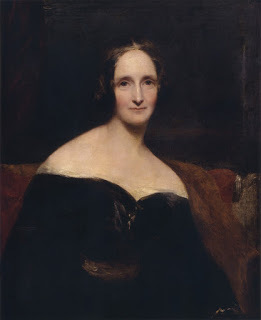 Mary Shelley is most famous for the enduring classic novel, Frankenstein. But who was Mary Shelley and how did a 19th century woman write such a story, one that would transcend generations?
Mary Shelley is most famous for the enduring classic novel, Frankenstein. But who was Mary Shelley and how did a 19th century woman write such a story, one that would transcend generations? Storytelling came to her honestly. She was the daughter of two of England's most prominent writers: William Godwin and Mary Wollstonecraft, but never knew her mother who died two days after giving birth to her.
When she was sixteen, she ran off with a married man, but not just any married man - the renowned poet Percy Shelley who became her greatest love, despite all his faults, one of which was his love affair with Mary's half-sister.
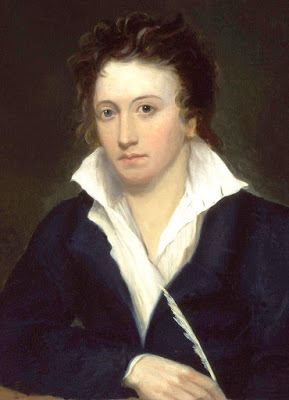 Mary and Percy travelled about Europe. They joined the scandalous poet Lord Byron in Switzerland. Lord Byron, a well known rogue and ladies man, led a debauched life, which had an impact on Mary and Percy. During their time together, the writers challenged each other to see who could write the most compelling horror story. Little did they know that Mary, unpublished and unknown, would be the hands down winner.
Mary and Percy travelled about Europe. They joined the scandalous poet Lord Byron in Switzerland. Lord Byron, a well known rogue and ladies man, led a debauched life, which had an impact on Mary and Percy. During their time together, the writers challenged each other to see who could write the most compelling horror story. Little did they know that Mary, unpublished and unknown, would be the hands down winner. Meanwhile, Percy's wife, devastated at being abandoned by her husband, committed suicide by jumping into a lake and drowning. Nevertheless, Percy and Mary got hitched not long thereafter.
Mary finished writing Frankenstein at the age of twenty and the book was published anonymously when she was 20. The literary critics of the day gave bad reviews, but the public at large loved it, especially more so after it had been developed into plays.
Sadness and grief plagued Mary for most of her short life. She gave birth to four children, but sadly, they all died except for one. Then, before she and Percy turned 30, Percy died when his boat sank. She never fell in love again and never remarried. She spent her days writing until she died at the age of 53 of a brain tumor.
Author Antoinette May has written deeply emotional and detailed account of Mary Shelley's life in the novel, THE DETERMINED HEART: THE TALE OF MARY SHELLEY AND HER FRANKENSTEIN.
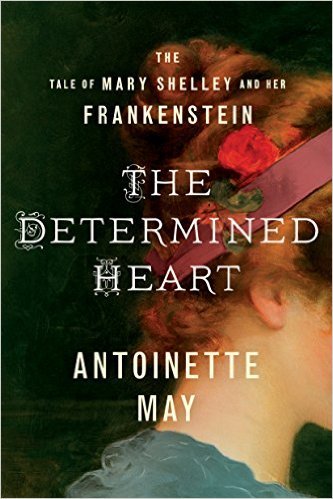 The Determined Heart reveals the life of Mary Shelley in a story of love and obsession, betrayal and redemption.
The Determined Heart reveals the life of Mary Shelley in a story of love and obsession, betrayal and redemption. The daughter of political philosopher William Godwin and feminist Mary Wollstonecraft, Mary Shelley had an unconventional childhood populated with the most talented and eccentric personalities of the time. After losing her mother at an early age, she finds herself in constant conflict with a resentful stepmother and a jealous stepsister. When she meets the Romantic poet Percy Bysshe Shelley, she falls deeply in love, and they elope with disastrous consequences. Soon she finds herself destitute and embroiled in a torturous love triangle as Percy takes Mary’s stepsister as a lover. Over the next several years, Mary struggles to write while she and Percy face ostracism, constant debt, and the heartbreaking deaths of three children. Ultimately, she achieves great acclaim for Frankenstein, but at what cost?
Reviewby Mirella Patzer Great Historical Fiction Book Review Blog
Antoinette May has re-envisioned Mary's life in a most comprehensive and compelling way. She brings to life the famous poets who were integral to Mary's life, namely Percy Bysshe Shelly and Lord Byron. In doing so, she shows us the darker side of these famous men, their human failings as well as their genius talents. The writing of Frankenstein is not foremost in the novel. Rather, the reader discovers the elements of Mary's life that gave rise to novel and the monster's creation.
What I enjoyed about this novel is that the characters were presented without prejudice, leaving the reader to decide whether they liked them or not, including Mary. Secret affairs, obsession, friendship, and debauchery line this novels pages, demonstrating their effects upon the main characters. Congratulations to the author for writing such an indepth biographical fiction novel about this fascinating woman's life. Truly unforgettable!
Amazon USA Amazon Canada










Published on November 06, 2015 11:30
October 28, 2015
Spectacles throughout history!

5th Century BC Magnifying Lens
The need to see when reading is as old as humanity. From the 5th century B.C., magnifying glasses were used by ancient Egyptians. They were a simple magnifyer, likely used by scholars or those of the noble classes.
By the medieval era, the 13th century, a hand held style that one could hold over the nose were invented in Pisa Italy. These were made with wood, rivet, and twine.

Medieval Eye Glasses (Recreation)
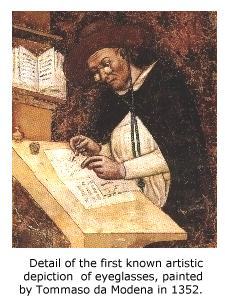
During this era, eye glasses were very important for the working classes. It is a well known fact that sight tends to deteriote when a person is in their 40's. If a craftsman could get his hands on a pair of glasses, he could extend his ability to work and be productive for up to twenty or more years. Thus, their popularity grew.
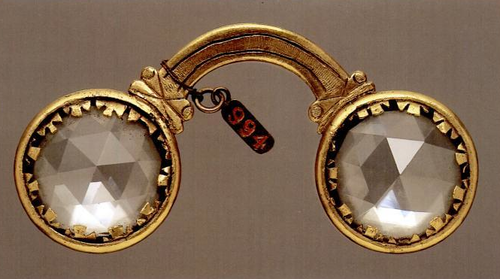
By the time of the Renaissance, glasses began to become more fashionable with guilding encircling rock crystal, and even gems. Still, they were considered a sign of old age and spectacles were worn only when absolutely necessary. Women especially detested the look of them on their faces.
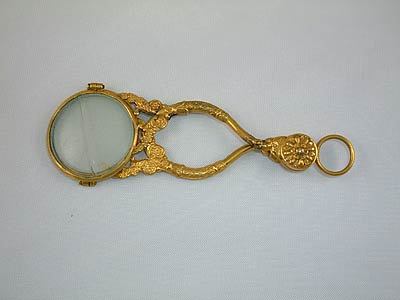
Round lensed, silver gilt French scissors lorgnette (ca 1750)
It wasn't until the 18th century that lorgnettes were invented, when eye glasses truly became a true fashion statement for women of all ages. Lorgnettes were born from scissor spectacles and had a single long handle built into them. Those who could afford these hand-held designs eagerly purchased them to avoid having glasses on their faces. In 1830, a French manufacturer designed a hinged bridge with a spring, which allowed the eyeglasses to be folded. Lorgnettes became so popular during the mid to late 1800s that manufacturers placed them into all manner of objects including mechanical pencils, fans, and ear trumpets. Ladies preferred these to the horrid looking spectacles they had to wear on their faces.
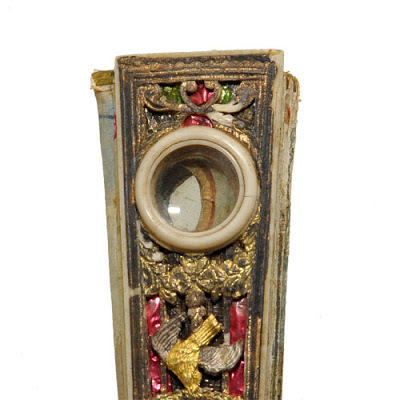
Lorgnettes inserted in a French fan
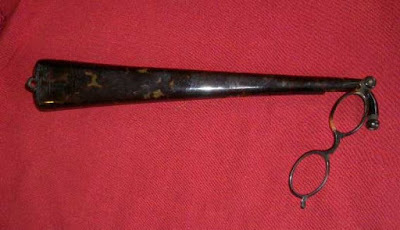
Lorgnettes attached to an ear trumpet
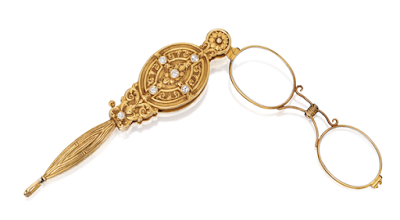 Fancy Lorgnettes sold in Tiffany's during the 1800's.
Fancy Lorgnettes sold in Tiffany's during the 1800's.Today, glasses are readily available for all ages, genders, and costs. Thousands of styles can be purchased to correct and enhance our sight whether they be prescription eyeglasses or sun glasses. Online stores now provide cheap eyeglasses that are so affordable, one can purchase many pairs and in different styles and colors to wear for any occasion or to match our garments.
Recently, I took the leap and decided to purchase eye glasses from an online store called THE GLASSES SHOP. I received the glasses today and was pleasantly surprised. Not only is the fit perfect, but the quality of the frame and lens is excellent. Here they are: Anaheim Wayfarer and the price is $35.95. They fit well and are very comfortable with no sliding down the nose and a firm fit behind the ears!

THE GLASSES SHOP has offered my readers 50% off on eyeglasses and sunglasses with free lenses (sale frames excluded). All you have to do is go to their website at
http://www.glassesshop.com/promotion/prescription-eyeglasses
Enter promotion code: GSHOT50










Published on October 28, 2015 12:20
October 25, 2015
The Legend of the Beijing Courtesan! A rags to riches to rags story!

Sai Jinhua
Sai Jinhua was born from humble beginnings. At the age of twelve, she was forced into prostitution, one of the few options open to an orphan. Her brothel was a pleasure boat where Jinhua serviced wealthy clients who lived nearby.
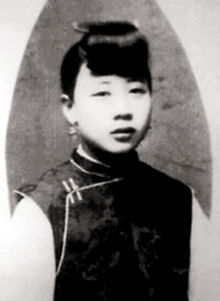
 One of her clients was Hong Jun, a very wealthy government official. The age difference between them was more than thirty years. In his capacity as an ambassador, he took her with him to Europe, a rare opportunity because Chinese women did not travel.
One of her clients was Hong Jun, a very wealthy government official. The age difference between them was more than thirty years. In his capacity as an ambassador, he took her with him to Europe, a rare opportunity because Chinese women did not travel.Sai Jinhua made the most of her time there - learning German, studying fashion, and making a splash among society's elite because of her uniqueness, dress, and tiny feet that had been painfully bound since childhood. After three years, they returned home to China, but Hong soon died. Disgusted by her role as a prostitute, Hong's family cast her out of the family penniless.
Alone and homeless, what was a girl to do? She returned to the only work that was familiar to her - prostitution. This time, she started up her own brothel in Beijing. Because of her connection with Hong, her notariety brought the curious, and as Madam, she enjoyed watching her business blossom.
The year was 1900 and the political climate was soon to explode. A group of rebels trained in Kung Fu were bent on ousting all foreign influence from their beloved China. At random, they began killing foreigners. And they were popular, even getting the nod from the empress herself. The movement grew and became more powerful, until finally a coalition of allies under the command of a German General named Von Waldersee, put a stop to their rebellion by marching into China and seizing control of the country.
 The Empress and her court fled Beijing. Those who failed to escape or were captured faced execution. Jinhua, who could speak German, was suddenly very important. Rumor has it that not only did she help bridge the communication gap between army officers and the Chinese, but she also saved many political prisoners from being beheaded. As her reputation for saving people grew, so did her brothel business. Rumors abounded and so did some of the legends surrounding her. Some called her an angel, others called her the General's whore. No one will ever know for certain for she kept much to herself. But bad luck had a way of finding Sai Jinhua. She was conficted of beating one of her prostitues who worked for her. Her sentence was banishment. She travelled to Shanghai where she remarried twice. Each time, her husbands died, and each time, their family's cast her out without a penny.
The Empress and her court fled Beijing. Those who failed to escape or were captured faced execution. Jinhua, who could speak German, was suddenly very important. Rumor has it that not only did she help bridge the communication gap between army officers and the Chinese, but she also saved many political prisoners from being beheaded. As her reputation for saving people grew, so did her brothel business. Rumors abounded and so did some of the legends surrounding her. Some called her an angel, others called her the General's whore. No one will ever know for certain for she kept much to herself. But bad luck had a way of finding Sai Jinhua. She was conficted of beating one of her prostitues who worked for her. Her sentence was banishment. She travelled to Shanghai where she remarried twice. Each time, her husbands died, and each time, their family's cast her out without a penny.  Under an assumed name, Sai Jinhua moved to Tianqiao, a city outside Beijing. She was middle-aged and used an assumed name to avoid attention. Nearly destitute, she was forced to seek support. Somehow, a journalist discovered who she truly was and published a story about her. Suddenly, everyone was interested, for they had never forgotten all the lives she had saved. People sent gifts and money, and became the subject of books, plays, songs, and poems.
Under an assumed name, Sai Jinhua moved to Tianqiao, a city outside Beijing. She was middle-aged and used an assumed name to avoid attention. Nearly destitute, she was forced to seek support. Somehow, a journalist discovered who she truly was and published a story about her. Suddenly, everyone was interested, for they had never forgotten all the lives she had saved. People sent gifts and money, and became the subject of books, plays, songs, and poems.In 1936 Sai Jinhua died. Controversy continued to plague her - is she national hero or liar? Despite all the rumors and the turbulent notariety, Sai Jinhua is remembered as a strong woman who faced adversity and had the courage to do what was right, even to the risk of punishment.
Sai Jinhua's life has been poignantly portrayed in a novel by Alexandra Curry entitled The Courtesan.
Opening Sentences: It is the hour of the Snake, a time of day when the sun works hard to warm the earth. The black cockerel with the all-knowing eye struts, haunting the execution ground as he always does, and Lao Guzi is wondering what he always wonders: Is the man guilty?
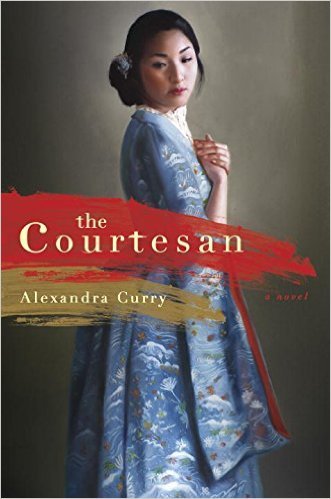 Synopsis: A timeless novel of one woman who bridged two worlds in a tumultuous era of East meets West. The Courtesan is an astonishing tale inspired by the real life of a woman who lived and loved in the extraordinary twilight decades of the Qing dynasty. To this day, Sai Jinhua is a legend in her native land of China, and this is her story, told the way it might have been. The year is 1881. Seven-year-old Jinhua is left an orphan, alone and unprotected after her mandarin father’s summary execution for the crime of speaking the truth. For seven silver coins, she is sold to a brothel-keeper and subjected to the worst of human nature. Will the private ritual that is her father’s legacy and the wise friendship of the crippled brothel maid be enough to sustain her? When an elegant but troubled scholar takes Jinhua as his concubine, she enters the close world of his jealous first wife. Yet it is Jinhua who accompanies him--as Emissary to the foreign devil nations of Prussia, Austro-Hungary, and Russia--on an exotic journey to Vienna. As he struggles to play his part in China's early, blundering diplomatic engagement with the western world, Jinhua’s eyes and heart are opened to the irresistible possibilities of a place that is mesmerizing and strange, where she will struggle against the constraints of tradition and her husband’s authority and seek to find “Great Love.” Sai Jinhua is an altered woman when she returns to a changed and changing China, where a dangerous clash of cultures pits East against West. The moment arrives when Jinhua’s western sympathies will threaten not only her own survival, but the survival of those who are most dear to her. A book that shines a small light on the large history of China’s relationship with the West, The Courtesan is a novel that distills, with the economy of a poem, a woman’s journey of untold miles to discern what is real and abiding.
Synopsis: A timeless novel of one woman who bridged two worlds in a tumultuous era of East meets West. The Courtesan is an astonishing tale inspired by the real life of a woman who lived and loved in the extraordinary twilight decades of the Qing dynasty. To this day, Sai Jinhua is a legend in her native land of China, and this is her story, told the way it might have been. The year is 1881. Seven-year-old Jinhua is left an orphan, alone and unprotected after her mandarin father’s summary execution for the crime of speaking the truth. For seven silver coins, she is sold to a brothel-keeper and subjected to the worst of human nature. Will the private ritual that is her father’s legacy and the wise friendship of the crippled brothel maid be enough to sustain her? When an elegant but troubled scholar takes Jinhua as his concubine, she enters the close world of his jealous first wife. Yet it is Jinhua who accompanies him--as Emissary to the foreign devil nations of Prussia, Austro-Hungary, and Russia--on an exotic journey to Vienna. As he struggles to play his part in China's early, blundering diplomatic engagement with the western world, Jinhua’s eyes and heart are opened to the irresistible possibilities of a place that is mesmerizing and strange, where she will struggle against the constraints of tradition and her husband’s authority and seek to find “Great Love.” Sai Jinhua is an altered woman when she returns to a changed and changing China, where a dangerous clash of cultures pits East against West. The moment arrives when Jinhua’s western sympathies will threaten not only her own survival, but the survival of those who are most dear to her. A book that shines a small light on the large history of China’s relationship with the West, The Courtesan is a novel that distills, with the economy of a poem, a woman’s journey of untold miles to discern what is real and abiding. Review by Mirella Patzer - http://www.historyandwomen.com
The exotic setting of old China has always fascinated me. This novel is set in the Qing Dynasty of the 1880's and opens with the execution of 7 year old Sai Jinhua's father. Her mother was a concubine who died in childbirth. Her father remarried, but he has been executed for political reasons. Unwanted, Jinhua's stepmother sells her to a brothel where she will live until she is old enough to begin work as a prostitute. The life there is very harsh and Sai Jinhau is subjected to having her feet bound. At twelve, Sai Jinhua loses her innocence and joins the other prostitues in their work. The novel follows her life and her rise when she is sold to Hong, a Chinese Diplomat who is beguiled by her resemblance to his first wife who committed suicide. Together, they travel to Vienna where Jinhua is a novelty. There, she experiences freedom and knowledge and gains self-confidence. But Hong dislikes her newfound strength and empowermentis and more and more he keeps her locked away from society.
Nicely researched, I thought the complexities of the Qing Dynasty were aptly described. The early life of this poor orphan who faced such horrendous circumstances was fascinating. I found the first half of the book unputdownable, and the pace slowed a bit thereafter, and I became a bit detached from the story. Some of the magic was lost, but the story still held my interest enough to get to the ending. A nice novel that swept me into a time and a world of long ago. A fascinating woman of history indeed!
Thank you to the author and publisher. I received a free copy of this book in exchange for an honest review.
Amazon USA Amazon Canada Amazon UK










Published on October 25, 2015 15:52
October 20, 2015
She Wolf and Queen Crusader - Eleanor of Aquitaine
Being a woman in the 12th century was fraught with turbulence. Arranged marriages for political reasons, the duty of bearing sons, ever constant warfare, intrigues of courtly life, and dangers of childbirth. These were the everyday fears women faced, especially Eleanor of Aquitaine.
One of the most powerful women of her time, she was the daughter of the Duke of Aquitaine and Count of Poitou. Not only was she a woman of great beauty, but she inherited immense wealth, making her one of the most sought-after women of her time.
When she was fifteen, she married Louis VII of France, a young price of her own age. When his father died, they were crowned King and Queen. They reined for fifteen years with Eleanor being the smarter one with a stronger, more vocal personality. During that time, Eleanor proved semi-fruitful. She provided her husband with two daughters, but no sons.
Eleanor was not afraid of war. In fact, she convinced her husband to initiate a crusade into the Holy Land and rode proudly at the front of their army. Her failure to provide her husband was one reason their marriage failed. It was annulled and Eleanor's vast dowry lands in Aquitaine and Poitiers were lawfully returned to her. She was thirty years old, still beautiful, still wealthy, and highly desirable. She soon came to the attention of Henry Plantaganet, the grandson of England's King Henry I. He was twelve years younger than Eleanor when they married. Her lands brought power and greater wealth to England, even more than that of her ex-husband.
Despite their stormy marriage, Eleanor provide herself a very good breeder, providing her husband with several sons, two of which would be destined to become English kings. All the while, she ruled her own lands and was a strong participant in English politics. Because of her love for the written word, she helped give light to Courtly Love.
As the years passed, her marriage deteriorated. She became a great adversary to her husband and even encouraged and supported her sons in a revolt against him. All their best efforts failed and her husband captured and arrested her. He kept her in custody in strict, less comfortable conditions in a monastery at Fontevrault, Anjou. She spent what remained of her life there and died at the age of 82 in the year 1204.

Eleanor's Tomb
In an exciting new trilogy, Author Elizabeth Chadwick brings to life Eleanor of Aquitaine. The first book, The Summer Queen, covers her life through the 2nd crusade to the annullment of her marriage to Louis VII, king of France. You can read my review at The Great Historical Fiction Blog. The Winter Crown is the second in this tremendously vivid and engaging trilogy.
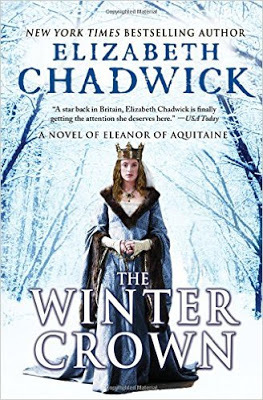 As Queen of England, Eleanor has a new cast of enemies―including the king. Eleanor has more than fulfilled her duty as Queen of England-she has given her husband, Henry II, heirs to the throne and has proven herself as a mother and ruler. But Eleanor needs more than to be a bearer of children and a deputy; she needs command of the throne. As her children grow older, and her relationship with Henry suffers from scandal and infidelity, Eleanor realizes the power she seeks won't be given willingly. She must take it for herself. But even a queen must face the consequences of treason... In this long-anticipated second novel in the Eleanor of Aquitaine trilogy, bestselling author Elizabeth Chadwick evokes a royal marriage where love and hatred are intertwined, and the battle over power is fought not with swords, but deception.Review by
Mirella Patzer
The Great Historical Fiction Book Review Blog
As Queen of England, Eleanor has a new cast of enemies―including the king. Eleanor has more than fulfilled her duty as Queen of England-she has given her husband, Henry II, heirs to the throne and has proven herself as a mother and ruler. But Eleanor needs more than to be a bearer of children and a deputy; she needs command of the throne. As her children grow older, and her relationship with Henry suffers from scandal and infidelity, Eleanor realizes the power she seeks won't be given willingly. She must take it for herself. But even a queen must face the consequences of treason... In this long-anticipated second novel in the Eleanor of Aquitaine trilogy, bestselling author Elizabeth Chadwick evokes a royal marriage where love and hatred are intertwined, and the battle over power is fought not with swords, but deception.Review by
Mirella Patzer
The Great Historical Fiction Book Review BlogElizabeth Chadwick continues this spellbinding tale of one of the most renowned queens of medieval times - Eleanor of Aquitaine. Her story has endured over the centuries, and has been immortalized in movies and books, but never before has there been a more indepth recreation of her life than this trilogy by this most beloved author. The Winter Crown picks up where The Summer Queen leaves us - Eleanor is newly married to the king of England. Full of conflict, Chadwick brings to life their tumultuous marriage clearly shows the strength and tenacity of this famous queen.
Although it is not necessary to read the trilogy in order, I highly recommend you do so to get the full history of this fascinating queen. Readers are eagerly awaiting the third book, The Autumn Throne, which is currently in the writing stage - it will definitely be worth the wait!
Amazon USA Amazon Canada Amazon UK









Published on October 20, 2015 12:51
October 7, 2015
Book Review - The Gilded Hour by Sara Donati
Opening Sentence: Early on a March morning on the cusp of spring, Anna Savard came in from the garden to find a young woman with a message that would test her patience, disrupt her day and send her off on an unexpected journey: a harbinger of change wearing the nursing habit of the Sisters of Charity, stnading in the middle of the kitchen.
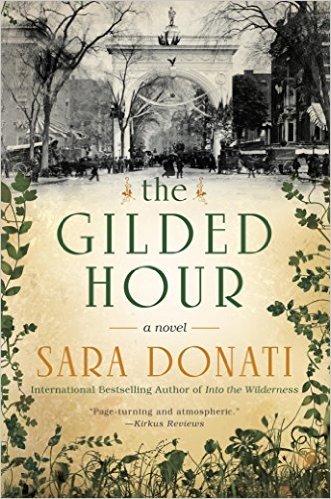 Synopsis: The international bestselling author of Into the Wilderness makes her highly anticipated return with a remarkable epic about two female doctors in nineteenth-century New York and the transcendent power of courage and love…
Synopsis: The international bestselling author of Into the Wilderness makes her highly anticipated return with a remarkable epic about two female doctors in nineteenth-century New York and the transcendent power of courage and love…
The year is 1883, and in New York City, it’s a time of dizzying splendor, crushing poverty, and tremendous change. With the gravity-defying Brooklyn Bridge nearly complete and New York in the grips of anti-vice crusader Anthony Comstock, Anna Savard and her cousin Sophie—both graduates of the Woman’s Medical School—treat the city’s most vulnerable, even if doing so may put everything they’ve strived for in jeopardy. Anna's work has placed her in the path of four children who have lost everything, just as she herself once had. Faced with their helplessness, Anna must make an unexpected choice between holding on to the pain of her past and letting love into her life. For Sophie, an obstetrician and the orphaned daughter of free people of color, helping a desperate young mother forces her to grapple with the oath she took as a doctor—and thrusts her and Anna into the orbit of Anthony Comstock, a dangerous man who considers himself the enemy of everything indecent and of anyone who dares to defy him. With its vivid depictions of old New York and its enormously appealing characters, The Gilded Hour is a captivating, emotionally gripping novel that proves Sara Donati is an author at the height of her powers.
Review by Mirella Patzer / History and Women
Sara Donati's latest novel is set in the late 1800's in New York City. At the heart of the story are two women, Anna and Sophie Savard who are both doctors specializing in women's health. Along with their passion for their work and the women they help, they both struggle to survive in the male oriented occupation amd the social norms and prejudices of the time - namely, against contraception and abortion, no matter the reason.
This is a long novel - about 700 pages or so. But don't let that distract you. Contained within every page are a barrage of historical details, accurate and relevant to the times. It is very much a novel about women's struggles and their fight to seize control of their own health. And although this character driven novel is not fast paced, it is nevertheless engrossing and a manual of learning for this very tumultuous time in history. Sara Donati includes numerous real, notorious characters of the time in addition to the well-crafted fictional ones. Her research into New York City before the turn of the century is definitely vivid, accurate, and compelling, as is her portrayal of doctors, nurses, and the health system of the time. All this makes this an important historical novel that not only entertains, but teaches us.
The characters face plenty of hardships and there is the plight of three orphaned Italian children forcefully separated by authorities. The main characters show compassion in coming to their aid and searching for the lost children. And of course, there is a love story too, some midwifery, and the rise of some women out of slavery. Yes, there is a lot going on, which makes this novel truly rich and compelling. Truly, this is historical women's fiction at its best and I highly recommend it.
Thank you to the author and publisher. I received a free copy of this book in exchange for an honest review.
Amazon USA Amazon Canada Amazon UK










 Synopsis: The international bestselling author of Into the Wilderness makes her highly anticipated return with a remarkable epic about two female doctors in nineteenth-century New York and the transcendent power of courage and love…
Synopsis: The international bestselling author of Into the Wilderness makes her highly anticipated return with a remarkable epic about two female doctors in nineteenth-century New York and the transcendent power of courage and love…The year is 1883, and in New York City, it’s a time of dizzying splendor, crushing poverty, and tremendous change. With the gravity-defying Brooklyn Bridge nearly complete and New York in the grips of anti-vice crusader Anthony Comstock, Anna Savard and her cousin Sophie—both graduates of the Woman’s Medical School—treat the city’s most vulnerable, even if doing so may put everything they’ve strived for in jeopardy. Anna's work has placed her in the path of four children who have lost everything, just as she herself once had. Faced with their helplessness, Anna must make an unexpected choice between holding on to the pain of her past and letting love into her life. For Sophie, an obstetrician and the orphaned daughter of free people of color, helping a desperate young mother forces her to grapple with the oath she took as a doctor—and thrusts her and Anna into the orbit of Anthony Comstock, a dangerous man who considers himself the enemy of everything indecent and of anyone who dares to defy him. With its vivid depictions of old New York and its enormously appealing characters, The Gilded Hour is a captivating, emotionally gripping novel that proves Sara Donati is an author at the height of her powers.
Review by Mirella Patzer / History and Women
Sara Donati's latest novel is set in the late 1800's in New York City. At the heart of the story are two women, Anna and Sophie Savard who are both doctors specializing in women's health. Along with their passion for their work and the women they help, they both struggle to survive in the male oriented occupation amd the social norms and prejudices of the time - namely, against contraception and abortion, no matter the reason.
This is a long novel - about 700 pages or so. But don't let that distract you. Contained within every page are a barrage of historical details, accurate and relevant to the times. It is very much a novel about women's struggles and their fight to seize control of their own health. And although this character driven novel is not fast paced, it is nevertheless engrossing and a manual of learning for this very tumultuous time in history. Sara Donati includes numerous real, notorious characters of the time in addition to the well-crafted fictional ones. Her research into New York City before the turn of the century is definitely vivid, accurate, and compelling, as is her portrayal of doctors, nurses, and the health system of the time. All this makes this an important historical novel that not only entertains, but teaches us.
The characters face plenty of hardships and there is the plight of three orphaned Italian children forcefully separated by authorities. The main characters show compassion in coming to their aid and searching for the lost children. And of course, there is a love story too, some midwifery, and the rise of some women out of slavery. Yes, there is a lot going on, which makes this novel truly rich and compelling. Truly, this is historical women's fiction at its best and I highly recommend it.
Thank you to the author and publisher. I received a free copy of this book in exchange for an honest review.
Amazon USA Amazon Canada Amazon UK










Published on October 07, 2015 12:30
October 6, 2015
Hoyden of the Week
Published on October 06, 2015 18:29
September 30, 2015
Win up to $1000 for the book launch of Wherever There is Light by Peter Golden
Enter to win up to $1000 Visa Gift Card
Author Peter Golden is celebrating the launch of his latest novel with this huge giveaway!
The prize will equal the number of people who enter (200 entrants = $200).The more people participate, the bigger the prize.
The giveaway begins at midnight on Oct. 1 and ends at midnight on Nov. 1.
Click on the Rafflecopter link below between the eligibility dates!
A Rafflecopter giveaway
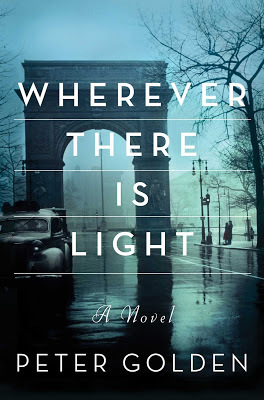
Book Synopsis: From the author of Comeback Love, a sweeping, panoramic tale of twentieth- century America, chronicling the decades-long love affair between a Jewish immigrant and the granddaughter of a slave
Julian Rose is only fifteen when he leaves his family and Germany for a new life in 1920s America. Lonely at first, he eventually finds his way—first by joining up with Longy Zwillman and becoming one of the preeminent bootleggers on the East Coast, and later by amassing a fortune in real estate.
Kendall Wakefield is a free-spirited college senior who longs to become a painter. Her mother, the daughter of a slave and founder of an African-American college in South Florida, is determined to find a suitable match for her only daughter.
African-American colleges rescued hundreds of German Jewish professors and their families from the Nazis, and one evening in 1938, Mrs. Wakefield hosts a dinner that reunites Julian with his mother and father, a famous philosopher. It also brings Julian and Kendall together for the first time. That encounter begins a thirty-year affair that will take the lovers from the beaches of Miami to the jazz clubs of Greenwich Village to postwar life in Paris, where they will mingle with Sartre, Picasso, and a host of other artists and intellectuals. Through his years serving in American intelligence and as an interrogator at the Nuremberg trials, what Julian wants most is to marry and find the joy that eluded his parents. Kendall craves her freedom, and after trading her oil paints for a Leica camera, becomes a celebrated photographer, and among the first American journalists to photograph the survivors of a liberated concentration camp. Yet despite distance, their competing desires, and the rapidly changing world, their longing for each other remains a constant in the ceaseless sweep of time.
Captivating and infused with historical detail, this is the epic tale of three generations, two different but intertwined families, and one unforgettable love story.
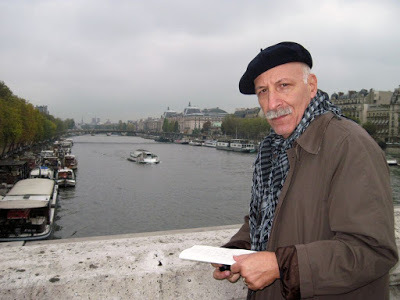
ABOUT PETER GOLDEN
Peter Golden is an award-winning journalist, historian, and novelist who, during the course of his long and varied career, has interviewed Presidents Richard Nixon, Gerald Ford, Ronald Reagan, and George H.W. Bush; Secretaries of State Henry Kissinger, Alexander Haig, George Shultz, and Lawrence Eagleburger; Israeli Prime Ministers Yitzhak Rabin, Shimon Peres, and Yitzhak Shamir; and Soviet President Mikhail Gorbachev. Golden’s Quiet Diplomat, published in 1992, was a biography of industrialist and political- insider Max M. Fisher. It made the Detroit Free Press bestseller list and was widely reviewed. Commentary magazine declared the biography a “meticulously researched and gracefully written book” that “gives us a concrete view of the emergence of American Jews into the mainstream of national politics since World War II.” In his review of the biography, historian and political analyst J.J. Goldberg wrote that Quiet Diplomat was “a disturbing, challenging book. It suggests, without answering, a wide range of questions about the relationship between the American Jewish community and its ‘leadership,’ and between the Diaspora community and the state of Israel. . . . In the end, [Golden] leaves readers free to draw their own conclusions.” One facet of diplomacy Golden uncovered was that during a 1965 visit Fisher made to President Dwight D. Eisenhower at his Gettysburg farm, the president told him that he regretted pushing Israel to pull out of the Sinai. This fact was essentially unknown to historians until Golden wrote about it, and the claim was backed up by President Richard Nixon, who told Golden: “Eisenhower. . . told me—and I am sure he told others—that he thought the action that was taken [at Suez] was a mistake.” Golden returned to journalism and won, among other kudos, the New York State Bar Association’s Media Award. Some of Golden’s work has appeared in the Detroit Free Press Magazine, The Albany Times Union, New Jersey Monthly, Microsoft’s eDirections, Beyond Computing, The Forward, and Capital Magazine. In 2000, Golden co-wrote the memoir, I Rest My Case, chronicling the life of J. Stanley Shaw, one of the preeminent bankruptcy attorneys in the United States. Golden’s first foray into fiction were the five interactive novels for computers he wrote as part of a joint venture between Imagic and Bantam Books that became known as the “Living Literature Series.” His interactive computer novel, Another Bow, was a Sherlock Holmes mystery set aboard the S.S. Destiny and was a Waldenbooks bestseller. In 2012, Golden’s traditional novel, Comeback Love, which explored the changes in America during the 1960s, was published by Atria Books, an imprint of Simon & Schuster. Reviews were excellent—“Golden’s breakout debut fiction is a passionate story of love, loss and reconciliation. . . Grab a handful of tissues. . . then start speculating on actors best suited to bring Gordon and Glenna to the big screen.” (Kirkus) “Glenna and Gordon’s romance rises and falls with the familiar but engrossing tempo of reckless, youthful passion.” (Publishers Weekly) “Golden’s first novel resonates with the great experiences typical of a life—love, sorrow, loss, lessons, resolutions. . . . The sometimes subtle, sometimes dramatic emotional dancing Gordon and Glenna engage in reads as honestly and accurately as any love story between two people who come together, come apart, then reconnect decades later.” (Booklist) “In this extraordinary debut, Golden unfolds the shimmering story of Gordon and Glenna, two joined-at-the-hip lovers, who meet and meld in the swinging sixties, only to be torn apart by the Vietnam War and Gordon’s draft lottery number. But Gordon never forgets Glenna, and years later, he tracks her down, fighting against the secrets of the past to struggle to rekindle their bond. A tumultuously wonderful novel about lost love, passion and regret.” (Caroline Leavitt, author of Pictures of You.) That same year, Golden’s history of the Cold War and its relationship to the Soviet Jewry movement, O Powerful Western Star! was published by Gefen Books. Of the history, Professor Henry L. Feingold, the dean of American Jewish historians, wrote: “The rescue of Soviet Jewry was an enormously complex happening. Now Peter Golden has woven the entire story in a broad-ranging tapestry of historical incidents and processes. A talented novelist has been let loose to make sense of this crucial exodus with the result that a dense history has been magically transformed. O Powerful Western Star! reads like a good novel.” Publishers Weekly deemed the book “an extensively researched history” and observed that “given its politically-charged subject matter, Golden is remarkably even-handed.” On November 3, 2015, Atria Books will publish Golden’s Wherever There Is Light, a sweeping, panoramic, historical novel that covers three generations in the intertwined lives of two families—the Roses, who are Jewish, and the Wakefields, who are African American. The novel delves into the little known history of the rescue of German Jews from the Nazis by traditionally African-American colleges. Julian Rose, a former bootlegger, and his love interest, Kendall Ann Wakefield, whose family founded the college and becomes a world-renowned photographer, are the main protagonists of the story. The novel looks at the problems of interracial love affairs starting in 1938 and takes place in New Jersey, South Florida, Greenwich Village and Paris. It concludes in 1966 by tracing the fate of all the characters, both major and minor, as they struggle to come to grips with the fact they were all as haunted by the times they lived in as they were by their own private battles. PETER GOLDEN BACKGROUNDPeter Golden was born in Newark, New Jersey and grew up in the suburbs of South Orange and Maplewood, New Jersey, where he graduated from Columbia High School. He attended Ohio University for two years then transferred to SUNY Albany, graduating with a BA in Philosophy. He lives in Guilderland, New York, with his wife, a communication professor at University at Albany, and their son.
Amazon USA Amazon Canada Amazon UK










Author Peter Golden is celebrating the launch of his latest novel with this huge giveaway!
The prize will equal the number of people who enter (200 entrants = $200).The more people participate, the bigger the prize.
The giveaway begins at midnight on Oct. 1 and ends at midnight on Nov. 1.
Click on the Rafflecopter link below between the eligibility dates!
A Rafflecopter giveaway

Book Synopsis: From the author of Comeback Love, a sweeping, panoramic tale of twentieth- century America, chronicling the decades-long love affair between a Jewish immigrant and the granddaughter of a slave
Julian Rose is only fifteen when he leaves his family and Germany for a new life in 1920s America. Lonely at first, he eventually finds his way—first by joining up with Longy Zwillman and becoming one of the preeminent bootleggers on the East Coast, and later by amassing a fortune in real estate.
Kendall Wakefield is a free-spirited college senior who longs to become a painter. Her mother, the daughter of a slave and founder of an African-American college in South Florida, is determined to find a suitable match for her only daughter.
African-American colleges rescued hundreds of German Jewish professors and their families from the Nazis, and one evening in 1938, Mrs. Wakefield hosts a dinner that reunites Julian with his mother and father, a famous philosopher. It also brings Julian and Kendall together for the first time. That encounter begins a thirty-year affair that will take the lovers from the beaches of Miami to the jazz clubs of Greenwich Village to postwar life in Paris, where they will mingle with Sartre, Picasso, and a host of other artists and intellectuals. Through his years serving in American intelligence and as an interrogator at the Nuremberg trials, what Julian wants most is to marry and find the joy that eluded his parents. Kendall craves her freedom, and after trading her oil paints for a Leica camera, becomes a celebrated photographer, and among the first American journalists to photograph the survivors of a liberated concentration camp. Yet despite distance, their competing desires, and the rapidly changing world, their longing for each other remains a constant in the ceaseless sweep of time.
Captivating and infused with historical detail, this is the epic tale of three generations, two different but intertwined families, and one unforgettable love story.

ABOUT PETER GOLDEN
Peter Golden is an award-winning journalist, historian, and novelist who, during the course of his long and varied career, has interviewed Presidents Richard Nixon, Gerald Ford, Ronald Reagan, and George H.W. Bush; Secretaries of State Henry Kissinger, Alexander Haig, George Shultz, and Lawrence Eagleburger; Israeli Prime Ministers Yitzhak Rabin, Shimon Peres, and Yitzhak Shamir; and Soviet President Mikhail Gorbachev. Golden’s Quiet Diplomat, published in 1992, was a biography of industrialist and political- insider Max M. Fisher. It made the Detroit Free Press bestseller list and was widely reviewed. Commentary magazine declared the biography a “meticulously researched and gracefully written book” that “gives us a concrete view of the emergence of American Jews into the mainstream of national politics since World War II.” In his review of the biography, historian and political analyst J.J. Goldberg wrote that Quiet Diplomat was “a disturbing, challenging book. It suggests, without answering, a wide range of questions about the relationship between the American Jewish community and its ‘leadership,’ and between the Diaspora community and the state of Israel. . . . In the end, [Golden] leaves readers free to draw their own conclusions.” One facet of diplomacy Golden uncovered was that during a 1965 visit Fisher made to President Dwight D. Eisenhower at his Gettysburg farm, the president told him that he regretted pushing Israel to pull out of the Sinai. This fact was essentially unknown to historians until Golden wrote about it, and the claim was backed up by President Richard Nixon, who told Golden: “Eisenhower. . . told me—and I am sure he told others—that he thought the action that was taken [at Suez] was a mistake.” Golden returned to journalism and won, among other kudos, the New York State Bar Association’s Media Award. Some of Golden’s work has appeared in the Detroit Free Press Magazine, The Albany Times Union, New Jersey Monthly, Microsoft’s eDirections, Beyond Computing, The Forward, and Capital Magazine. In 2000, Golden co-wrote the memoir, I Rest My Case, chronicling the life of J. Stanley Shaw, one of the preeminent bankruptcy attorneys in the United States. Golden’s first foray into fiction were the five interactive novels for computers he wrote as part of a joint venture between Imagic and Bantam Books that became known as the “Living Literature Series.” His interactive computer novel, Another Bow, was a Sherlock Holmes mystery set aboard the S.S. Destiny and was a Waldenbooks bestseller. In 2012, Golden’s traditional novel, Comeback Love, which explored the changes in America during the 1960s, was published by Atria Books, an imprint of Simon & Schuster. Reviews were excellent—“Golden’s breakout debut fiction is a passionate story of love, loss and reconciliation. . . Grab a handful of tissues. . . then start speculating on actors best suited to bring Gordon and Glenna to the big screen.” (Kirkus) “Glenna and Gordon’s romance rises and falls with the familiar but engrossing tempo of reckless, youthful passion.” (Publishers Weekly) “Golden’s first novel resonates with the great experiences typical of a life—love, sorrow, loss, lessons, resolutions. . . . The sometimes subtle, sometimes dramatic emotional dancing Gordon and Glenna engage in reads as honestly and accurately as any love story between two people who come together, come apart, then reconnect decades later.” (Booklist) “In this extraordinary debut, Golden unfolds the shimmering story of Gordon and Glenna, two joined-at-the-hip lovers, who meet and meld in the swinging sixties, only to be torn apart by the Vietnam War and Gordon’s draft lottery number. But Gordon never forgets Glenna, and years later, he tracks her down, fighting against the secrets of the past to struggle to rekindle their bond. A tumultuously wonderful novel about lost love, passion and regret.” (Caroline Leavitt, author of Pictures of You.) That same year, Golden’s history of the Cold War and its relationship to the Soviet Jewry movement, O Powerful Western Star! was published by Gefen Books. Of the history, Professor Henry L. Feingold, the dean of American Jewish historians, wrote: “The rescue of Soviet Jewry was an enormously complex happening. Now Peter Golden has woven the entire story in a broad-ranging tapestry of historical incidents and processes. A talented novelist has been let loose to make sense of this crucial exodus with the result that a dense history has been magically transformed. O Powerful Western Star! reads like a good novel.” Publishers Weekly deemed the book “an extensively researched history” and observed that “given its politically-charged subject matter, Golden is remarkably even-handed.” On November 3, 2015, Atria Books will publish Golden’s Wherever There Is Light, a sweeping, panoramic, historical novel that covers three generations in the intertwined lives of two families—the Roses, who are Jewish, and the Wakefields, who are African American. The novel delves into the little known history of the rescue of German Jews from the Nazis by traditionally African-American colleges. Julian Rose, a former bootlegger, and his love interest, Kendall Ann Wakefield, whose family founded the college and becomes a world-renowned photographer, are the main protagonists of the story. The novel looks at the problems of interracial love affairs starting in 1938 and takes place in New Jersey, South Florida, Greenwich Village and Paris. It concludes in 1966 by tracing the fate of all the characters, both major and minor, as they struggle to come to grips with the fact they were all as haunted by the times they lived in as they were by their own private battles. PETER GOLDEN BACKGROUNDPeter Golden was born in Newark, New Jersey and grew up in the suburbs of South Orange and Maplewood, New Jersey, where he graduated from Columbia High School. He attended Ohio University for two years then transferred to SUNY Albany, graduating with a BA in Philosophy. He lives in Guilderland, New York, with his wife, a communication professor at University at Albany, and their son.
Amazon USA Amazon Canada Amazon UK










Published on September 30, 2015 23:00








